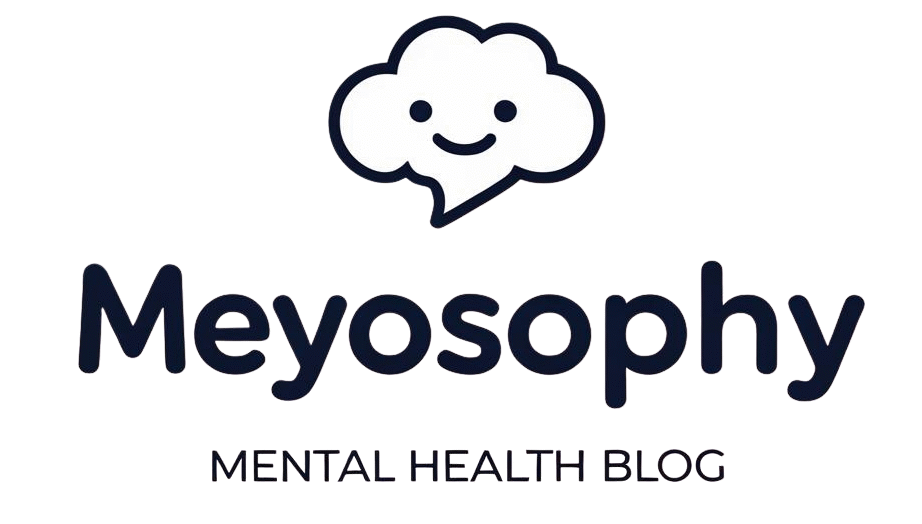Note: This article explains the physical and emotional sensations that often come with panic attacks (like a racing heart, dizziness, or shortness of breath). The information here is for education only, not a substitute for professional medical advice. If you’re worried about your symptoms, please consult a qualified healthcare provider. Read the full disclaimer here.
If you’ve ever experienced a panic attack, you know how all consuming it can feel. Your chest tightens, your breath seems shallow, your heart pounds so fast you’re sure something is wrong: maybe you’re dying, maybe you’re losing control. In reality, a panic attack is your body’s alarm system firing on overdrive, even when there’s no real threat [1].
The good news? Even though panic attacks feel terrifying, they are not harmful, and there are effective ways to cope both during and after. With the right strategies, you can support your body, ease your mind, and begin to retrain your nervous system to respond with more calm in the future. This guide will walk you through practical tools you can use in the moment, recovery techniques once the peak has passed, and long-term approaches [2].
Quick-Calm Techniques You Can Use in the Moment
When a panic attack begins, your body is flooded with adrenaline and stress hormones. This chemical surge creates intense physical sensations: racing heart, shortness of breath, dizziness, tingling, chest pressure and much more. These symptoms are scary, but not dangerous [3]. The key is to give your body the message that you’re safe. Want to read more about what happens in your body during a panic attack? Read my previous article about that here.
Here are five quick-calming strategies you can try when panic rises:
- Grounding with the 5-4-3-2-1 Method
Look around and name 5 things you see, 4 things you feel, 3 things you hear, 2 things you smell, and 1 thing you taste. This pulls your attention out of the “what if” spiral in your mind and anchors you in the present moment. - Slowed Breathing
Panic often comes with rapid, shallow breathing, which makes symptoms worse. Try inhaling gently through your nose for 4 seconds and exhaling slowly through your mouth for 6–7 seconds. Longer exhales activate the parasympathetic nervous system, your body’s natural “calm down” switch [3]. - Progressive Muscle Relaxation
Tight muscles tell your brain you’re in danger. Release tension by tensing one muscle group at a time (like your shoulders), holding for 5 seconds, then releasing. Move through your body from head to toe. - Cool Reset
Splashing cool water on your face or holding a cold object can interrupt the adrenaline loop. This small shock signals your nervous system to reset. - Gentle Movement
If you feel jittery or restless, slow movement can help discharge stress energy. Walking, swaying, or stretching can bring you back into your body in a soothing way.
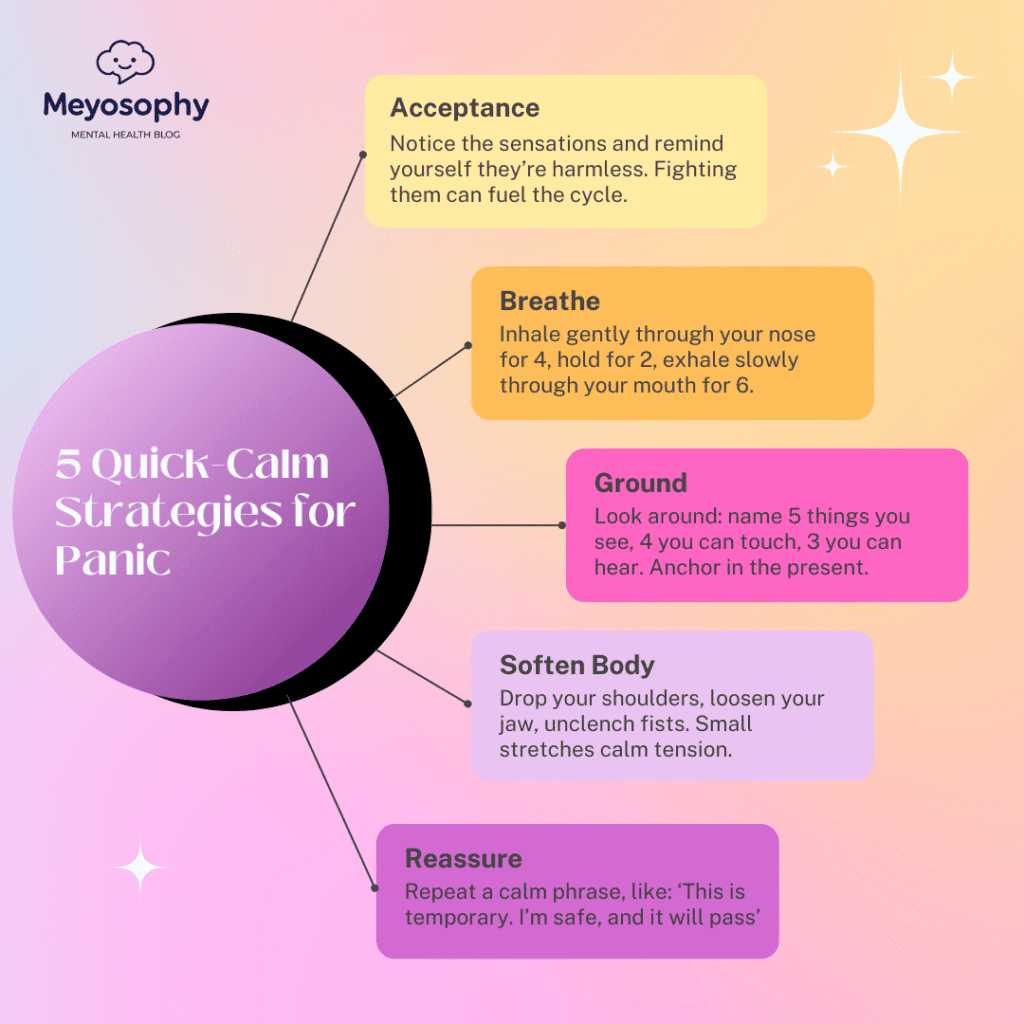
Helpful Self-Talk: Reassuring Your Mind
The thoughts that accompany panic attacks often fuel the fire: “I’m going to faint.” “This won’t stop.” “I must be going crazy.” Replacing these with calming, realistic self-talk helps break the cycle [2].
Here are some phrases you can repeat to yourself:
- “This is panic, not danger.”
- “My body is sending false alarms, but I am safe.”
- “Panic always passes, this one will too.”
- “I don’t need to fight it. I can let the wave rise and fall.”
It might feel strange at first, but practicing these phrases helps rewire your automatic responses. Over time, your brain learns to recognize panic for what it is: uncomfortable, but not life-threatening [4].
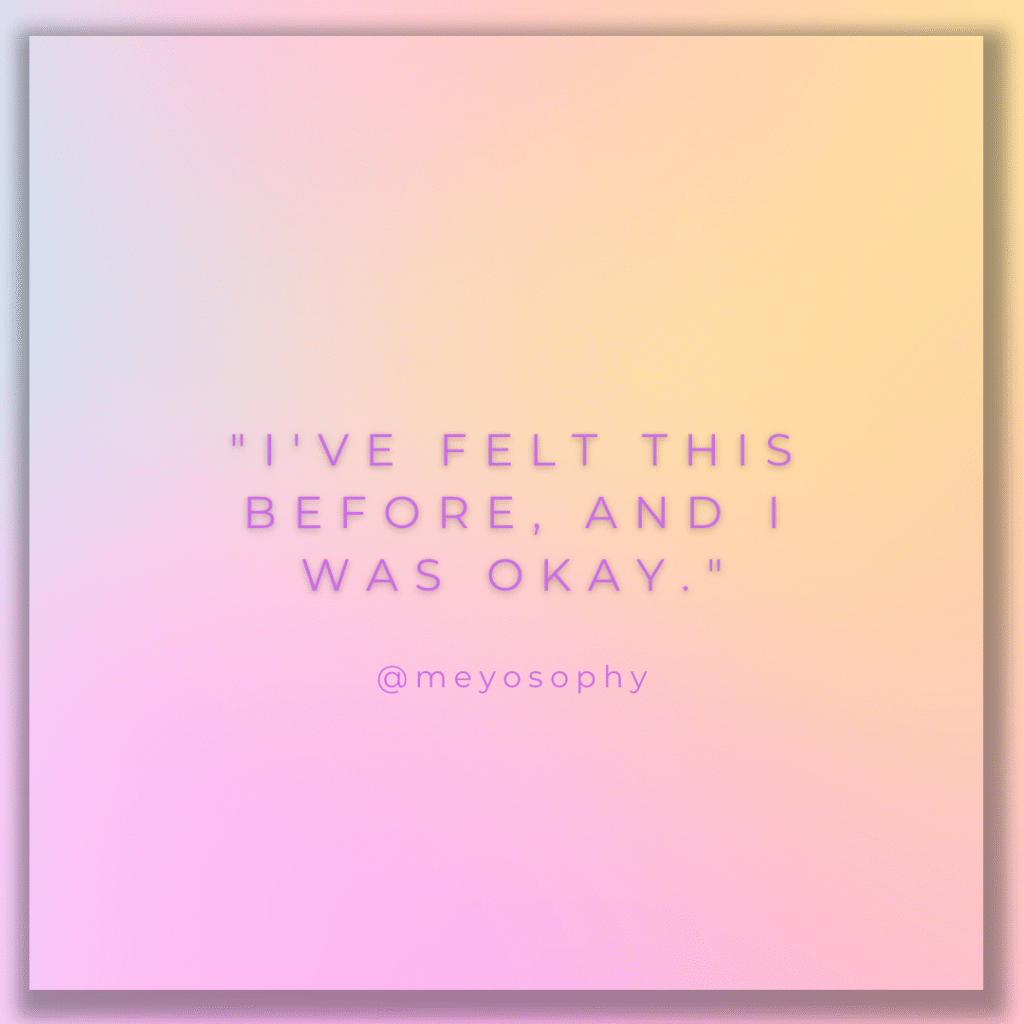
After the Storm: Recovery Without Rumination
Once a panic attack peaks, it naturally begins to fade as your body uses up the surge of stress hormones. Many people, however, stay stuck in post-panic rumination: replaying what just happened, worrying about when the next one will strike, or criticizing themselves. This mental loop keeps stress levels high [2].
To support recovery, try this:
- Hydrate: Sip water or herbal tea to signal care and reset your focus.
- Stretch or Rest: Move your body gently or rest for a few minutes to ease tension. Be mindful with it.
- Write down Observations: Write down what you noticed (“My heart pounded, then it slowed. It passed.”). Keep it factual, not analytical. Don’t ruminate, write it down and put it away.
- Self-Talk: Remind yourself: “That was tough, but I handled it. It passed.” Be kind to yourself. Panic attacks are not fun to go through (understatement).
- Return to Normal: As soon as you feel ready, go back to what you were doing. This shows your brain that life continues and panic doesn’t control you. At a later time, go back to where you had the panic attack. Avoiding makes your world smaller and suggests to your system, that there was something to be scared of. Of course this doesn’t count for actual unsafe situations [3].
Think of this like a cool-down for your nervous system, just as important as the main event.
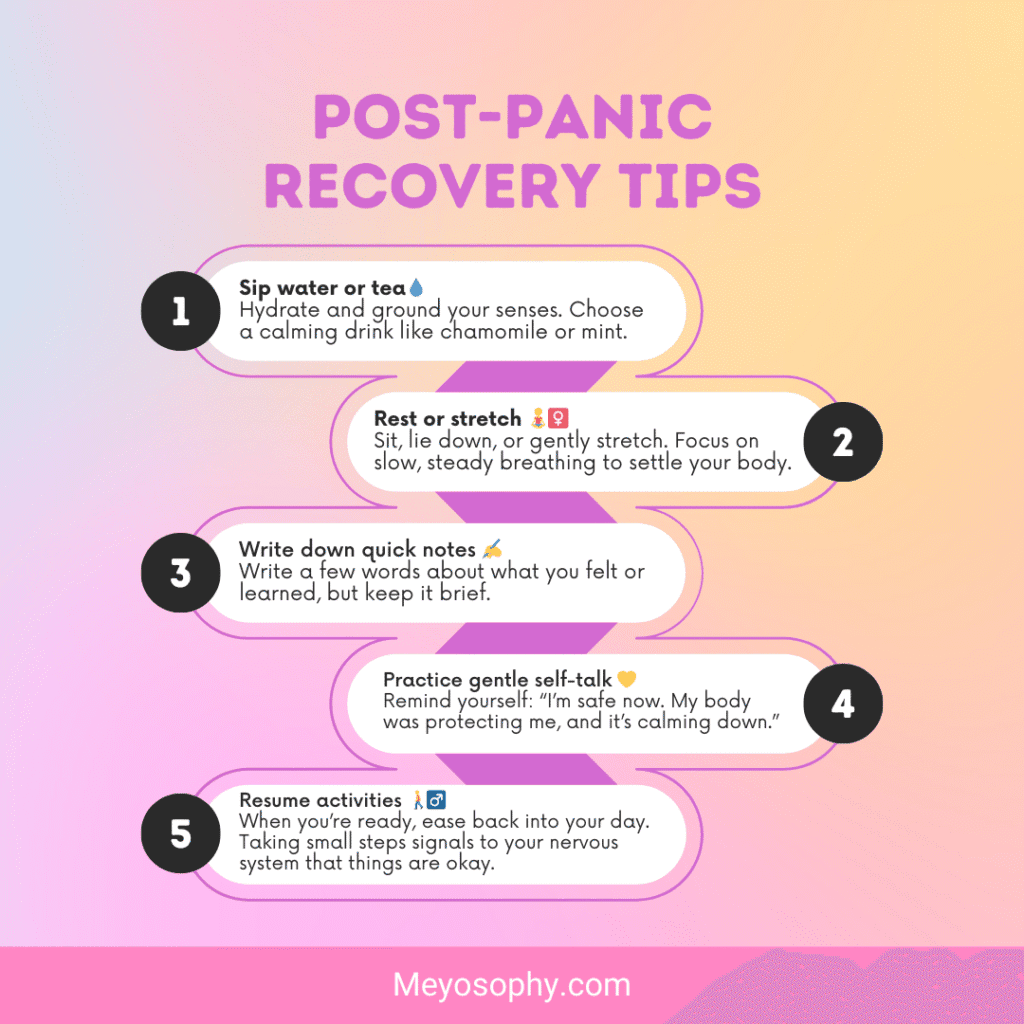
Long-Term Nervous System Care
While quick fixes help in the moment, long-term care reduces how often panic shows up. Panic attacks don’t happen in a vacuum, they’re more likely when your body is already under stress, overtired, or running on empty [2].
Here are daily habits that strengthen resilience:
- Consistent Sleep: Aim for regular bed and wake times. Sleep regulates stress hormones and nervous system balance.
- Steady Nutrition: Skipping meals or big blood sugar swings can trigger panic-like sensations. Eat balanced meals with protein, healthy fats, and slow carbs.
- Movement: Gentle exercise like walking, yoga, or swimming helps your body release tension and regulate adrenaline [3].
- Mindfulness or Meditation: Even 5 minutes of observing your breath each day helps train your brain to stay present instead of spiraling [4].
- Connection: Spend time with people (or pets) who help you feel safe and supported. Social connection is a powerful regulator.
- Stress Management: Practices like journaling, breathing exercises, or creative hobbies act as outlets for emotional energy.
When Panic Becomes Panic Disorder
It’s normal to have an occasional panic attack during stressful periods. But when they happen repeatedly, lead you to avoid places or situations, or make you live in fear of the next one, this may be panic disorder [1].
Signs it may be time to seek help include:
- Repeated panic attacks over weeks or months.
- Persistent worry about having another attack.
- Avoidance of situations where attacks happened before.
- Significant disruption in daily life.
The important thing to know: panic disorder is highly treatable. Professional support can give you lasting tools and reduce symptoms dramatically [2].
Therapy & Professional Support Options
- Cognitive Behavioral Therapy (CBT): Helps identify panic-triggering thought patterns and teaches new, calmer responses. Considered the most effective approach [1].
- Exposure Therapy: Gradual exposure to feared sensations (like racing heart) or situations. This teaches your brain they’re safe [4].
- Acceptance and Commitment Therapy (ACT): Focuses on acceptance of bodily sensations rather than resistance, reducing the struggle.
- Mindfulness-Based Therapy: Trains awareness and calm observation, reducing panic’s power.
- Medication: Doctors may prescribe SSRIs, SNRIs, or short-term benzodiazepines. These are most effective when paired with therapy [2].
You’re not alone, and effective treatment exists. If you’re struggling, it might be worth considering one of these.
Disclosure: This post contains Amazon affiliate links. That means if you click and make a purchase, I may earn a small commission at no extra cost to you. I only recommend products I truly believe in. Thank you for supporting this blog and helping me keep the content free and helpful! 🩵
Helpful Books & Apps
Alongside therapy, many people benefit from self-help tools they can return to daily. My favorite resources include:
Books:
Dare: The New Way to End Anxiety and Stop Panic Attacks by Barry McDonagh.
When Panic Attacks by Dr. David Burns.
The Anxiety and Phobia Workbook by Edmund Bourne.
Apps:
DARE Response App (guided support through panic).
Calm and Headspace (guided meditations and breathing).
Breathwrk (easy breathing exercises to regulate panic).
These tools won’t replace therapy, but they can empower you with daily coping practices.
My Personal Take
I’ve had multiple panic attacks myself and they were some of the scariest moments of my life. In those moments, I truly thought I was going to die or lose my mind. The more I fought against the sensations, the worse it got.
What changed everything for me was learning acceptance: letting the wave rise and fall, rather than trying to push it away. It wasn’t easy at first, but over time it gave me back a sense of control. The book Dare by Barry McDonagh played a big role in shifting my perspective. It reminded me that alongside the physical side of panic, there’s also the mental side and learning to meet panic with acceptance rather than fear makes all the difference.
I still don’t like panic attacks, but I think nobody does. Be kind to yourself, it’s hard and scary, but you can get much better at experiencing them.
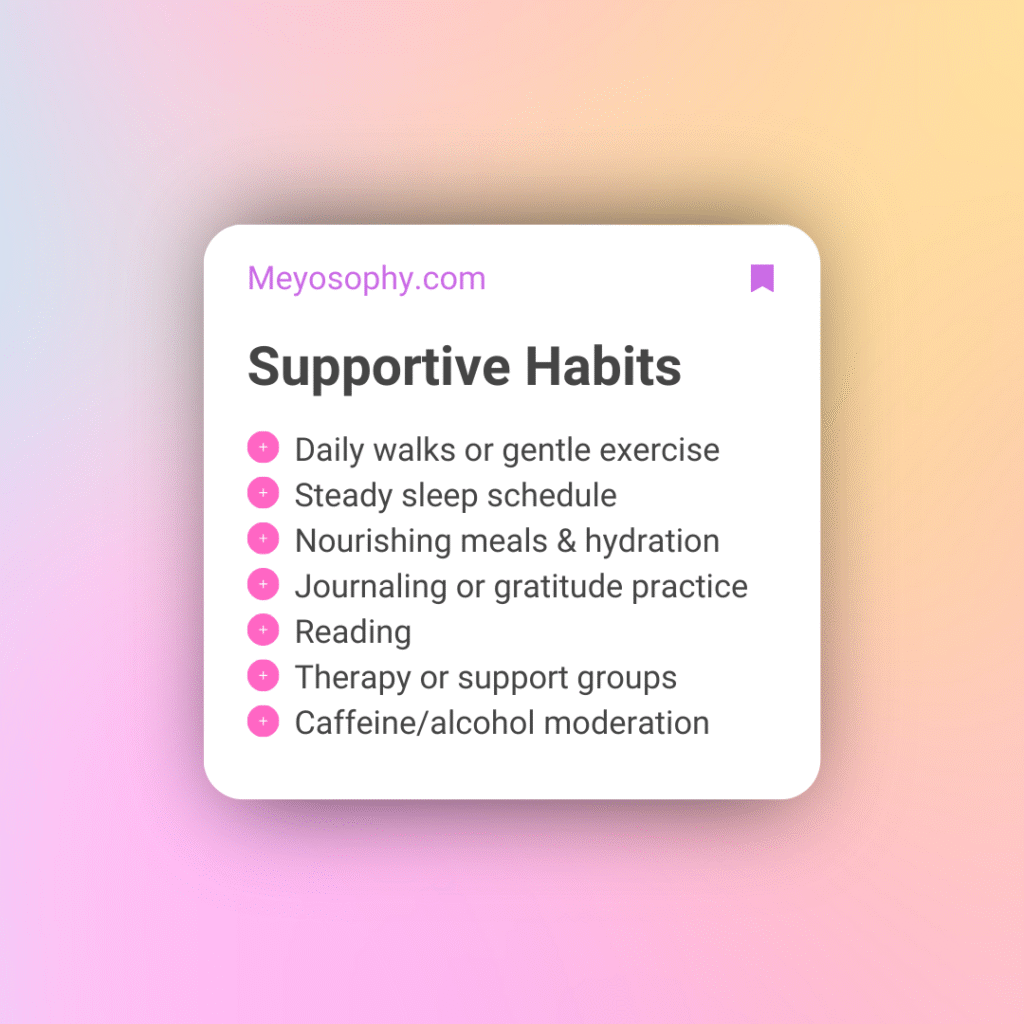
Closing Message
Panic attacks may feel unbearable, but they are survivable and they always pass. By combining quick-calming tools, supportive self-talk, post-panic recovery, and long-term care, you give your body and mind the chance to reset. If panic attacks are frequent or overwhelming, professional support can help you regain your freedom.
Every time you practice a skill: whether it’s breathing, grounding, or acceptance, you are teaching your nervous system one powerful truth: you are safe, even in panic.
Sources
- American Psychological Association. (2023). Panic Disorder.
- National Institute of Mental Health. (2023). Panic Disorder: When Fear Overwhelms.
- Harvard Health Publishing. (2022). What to do when panic attacks.
- Clark, D. M. (1986). A cognitive approach to panic. Behaviour Research and Therapy.
Disclaimer: I’m not a medical professional, and what I share here comes from general knowledge and personal experience. Panic attacks can feel overwhelming, and while these descriptions may help you better understand them, they are not a substitute for professional care. If you’re struggling with panic attacks or physical symptoms that worry you, please reach out to a healthcare professional, you don’t have to go through it alone. This article is for informational and educational purposes only and is not a substitute for professional medical advice, diagnosis, or treatment. Never disregard professional advice or delay in seeking it because of something you have read here. If you are experiencing frequent or severe panic attacks, or if they are interfering with your daily life, please reach out to a licensed healthcare professional for support. If you ever feel like you might be in immediate danger or are thinking of harming yourself, call your local emergency number right away. If you’re in the U.S., you can call or text 988 anytime. For help in other countries, visit https://findahelpline.com.
